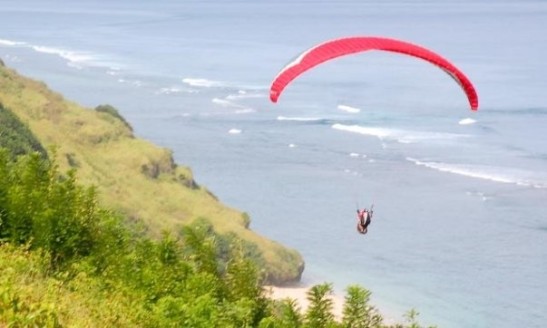 Time to pick up from my previous post.
Time to pick up from my previous post.
Bali is a popular tourist destination, and there are so many reasons why. It has enough to cover the whole spectrum of travelers – from luxury hotel hoppers to backpackers, art and history buffs to adrenaline junkies. Here are my crib notes on the island.
For the Art Aficionado / Culture Vulture
Ubud and its surrounds should be your haunt, if interesting (and relatively cheap) arts and crafts is your thing. The town of Celuk is known for silversmithing, Mas for woodcarving, and Tohpati for traditional batik weaving and printing.
Redecorating? Bali is as good a place as any to do some furniture shopping, particularly for Asian teak.
Art galleries abound in Ubud, and there are a few quaint museums around Sanur. As luck would have it, Museum La Mayeur was closed on the only day I was in that neck of the woods. (It comes highly recommended by Lonely Planet, though.) Other museums you might visit are the Neka Art Museum and Museum Puri Lukisan, both in Ubud. These house local Balinese art, and the latter is a stone’s throw away from Puri Saren (Ubud) Palace.
Bali is one of the few islands in Indonesia that is predominantly Hindu. For the tourist, this means one thing – lots of spectacular temple architecture. Tanah Lot is probably the most photographed of them all, and beware the hordes of visitors at sunset. (We opted out of this experience, but you are more than welcome to tell me about yours!)
One of the bigger temple complexes is Taman Ayun, located north of Denpasar. It’s got a bit more history and a lot less tourists; those who want to get far from the madding crowd will do well to visit this sight. If you happen to be travelling during one of their frequent religious festivals, you may just encounter a coterie of finely dressed women making their way to the temple.
Another top attraction is Ulu Watu, the temple that is perched on the cliff on the southernmost part of the Nusa Dua peninsula. Best time to head visit is late afternoon, before sundown. The view is spectacular (to put it mildly). There is also a fire dance (kecak) that is held every evening, around 5pm.
Well worth the trek is Gunung Kawi, an ancient monument at the foot of a mountain. It’s slightly north of Ubud, nestled in the forests of central Bali. Brace yourself for a climb of 270 steps. Double this up with a visit to Goa Gajah, or Elephant Cave, and you’ve got yourself booked for the entire afternoon. I’m hoping to visit these two places the next time I find myself in the island!
If you’re pressed for time, within Ubud itself is the Monkey Forest Sanctuary, which houses a few temples. Ideal for those who don’t mind walking along lush vegetation, with a few not-so-tame monkeys as companions.
A cultural trip to Bali would not be complete without a stop at Batubulan for their traditional Balinese dance. You can take photos with the scary Barong monster afterwards.
For the Nature Lover
A walk amongst the paddy fields of Ubud came highly recommended by my Indonesian friends, and it did not disappoint. There will be better walks than others, but I personally do not feel that a guide is required. Just wander around to your heart’s content – there will always be a way to get back to town.
Unbeknownst to me, Bali has its own Botanic Gardens. It requires a drive up north, towards the slopes of Gunung Pohen. I’d have made the trip had I discovered such a place existed.
For the Adrenaline Junkie / Outdoors Adventure Seeker
One of the things that will surely make you break a sweat is a climb up Gunung Agung, Bali’s sacred peak. Best times to climb are between April and October. Check with local guides for restrictions due to religious ceremonies. Visit Besakih temple while you’re there – one of the trekking routes passes that way.
White water rafting is the most popular adventure sport amongst visitors to Bali, and there are two Category III rivers in the island – Ayung (outside Ubud) and Telaga Waja (near Gunung Agung). There are only a few licensed groups that provide white water rafting tours, and these are the ones you should go with. Aside from higher safety standards, they’ll have you covered with insurance (not that Cat III rapids are death-defying, but you never know what could happen). Frommers can give you a low-down on who to contact for some action.
This post would be incomplete if I didn’t mention surfing. Mosey over to Kuta Beach for some lessons – a number of shops line the beachfront. Waves are pretty good most of the year, and the instructors will cover the basics on dry land before you get your feet wet. For the pros, Uluwatu has the gnarliest (or most publicised) breaks around.
If you’re more an aerial activity person, try paragliding from the cliffs of Nusa Dua. Trade winds are seasonal, from May to October – so gliding any time outside of that window would be wasted effort. The view from above is worthwhile.
There are a number of beaches to choose from, but the promenade that has more upmarket establishments would be Nusa Dua. My personal choice would be Sanur, which is more local and laid-back than Kuta (formerly known as Dreamland).
Bali truly has something for everybody. For more cosmopolitan folks, there are numerous outlet shopping opportunities and clubs to fill your nightlife. For those who want to get away, spas and retreats are tucked into every other corner of the island. If you’re at a loss on where to go for your next vacation, Bali would be an easy choice. You can just decide what to do when you get there.





